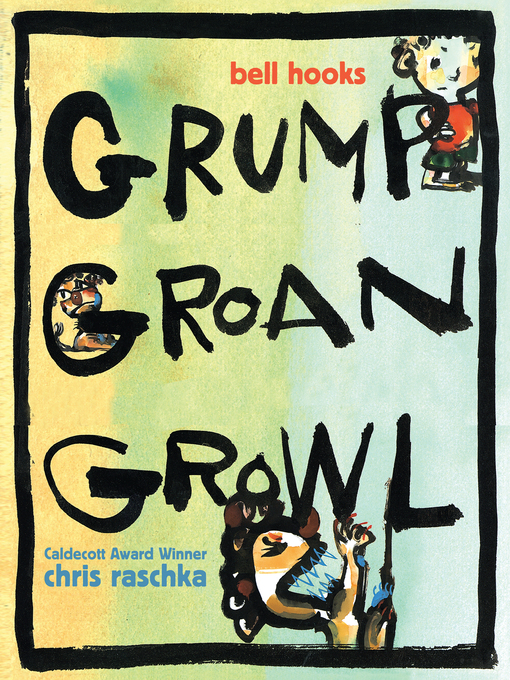- Popular Magazines
- Just Added
- Cooking & Food
- Fashion
- Health & Fitness
- Home & Garden
- News & Politics
- See all magazines collections
Here's a positive way to face our bad, grumpy, and wild moods! Acclaimed writer bell hooks offers a vision of calm with a soothingly rhythmic text, while award-winning artist Chris Raschka's vibrant art adds a healthy dose of compassion and humor, reminding readers that sometimes you just have to go inside and let it slide.
-
Creators
-
Publisher
-
Release date
November 4, 2017 -
Formats
-
Kindle Book
-
OverDrive Read
- ISBN: 9781368017046
-
-
Languages
- English
-
Reviews
-
Publisher's Weekly
Starred review from April 7, 2008
Hooks and Raschka (Be Boy Buzz
; Skin Again
) charge this temperamental book with few words but ample emotion. The alliterative title alone demands a loud delivery, and each of the three key words gets a noisy spread all to itself (“Grump-/ Groan-/ Growl/ Bad mood on the prowlâ€). Raschka, working in loose India ink over airy, multicolored watercolor wash, scrawls a short-legged, leonine monster and its alter ego, an angry curly-haired child. The creature recalls one of Sendak's Wild Things, albeit roughly sketched with a thick brush. A zigzag blue line of teeth superimposed across the glowering monster's dark mouth in several images implies a temporary sharpness, but not permanent antagonism. Similarly, hooks's words acknowledge how hard it is to avoid negativity (“Can't stand outside/ Can't hideâ€). At the conclusion, the words “Just go inside,†recommend a time-out for easing out of the mood. On the closing page, “Just let it slide,†the S of “slide†becomes a chair where the once-belligerent child lounges and his inner monster naps beneath (not gone, but relaxed). With its intensity and understanding, this bad-mood book rivals Jules Feiffer's I'm Not Bobby!
and Molly Bang's When Sophie Gets Angry—Really, Really Angry...
. Ages 3-up. -
School Library Journal
March 1, 2008
PreS-Gr 2-Expressionistic art and economical poetry combine smoothly to create an inspiring model of self-control. A young gender-neutral child with curly hair is in a BAD MOOD. An alter-ego beast grumps, groans, and growls, trying in vain to hide or escape from its own feelings. Only when the child/beast faces and accepts the feelings can the bad mood dissipate. It is significant that the temperamental beast is not portrayed as something bad to be defeated; as the child makes a conscious effort to chill, the bad-mood beast is calmed and, in the final scene, sleeps companionably by the child's side. Many "anger management" picture books advise letting it all out by running or screaming. This one is different; "Just go inside/Just let it slide," it says, modeling a more internal form of comfort. It's a kind of variation on "Where the Wild Things Are"Max imagined temporarily becoming a Wild Thing, while this child embraces the constant beast within and calms it through love and acceptance. Thick, almost tactile lines of paint are slathered onto the pages with gusto, capturing a feeling of movement and strong emotion. Hand-painted lettering is incorporated into the illustrations so that words and images interact, as in the final "let it slide" where the S becomes a seat for the relaxed child. While abstract and symbolic, this book has a healthful and hopeful message that readers will connect with emotionally."Heidi Estrin, Feldman Children's Library at Congregation B'nai Israel, Boca Raton, FL"Copyright 2008 School Library Journal, LLC Used with permission.
-
Booklist
February 1, 2008
Like Sendaksclassic Where the Wild Things Are (1963), the latest collaboration between hooks and Raschka acknowledges the ferocity of childhood emotions and suggests the wisdom of allowing them to run their course. Here, however, the emotions themselves, anthropomorphized (in true Sendakian spirit) as a wild beast, take center stage rather than being digestedwithin alarger imaginary narrative.The beginning is memorable: hooks stompingrefrain, Grump / Groan / Growl/ Bad mood on the prowl, sprawls across the spreads in thickly brushed, freehand letters as the creature, caged within a thick, black frame, paces and roars. Unfortunately, Raschkas watercolors, although they nicely express the volatile, muddy soup of an irritable childs subconscious, dont doenough to elucidate the texts concluding, therapeutic ideasabout taming the bad-mood beast(just go inside, hookssuggests, but inside where?). Still, even if the books message is sometimes too obscure, fewpicture bookscan match the visceral punch of this ones opening, which does for bad moods what Sendaks wild rumpus sequence did for bedtime naughtiness.(Reprinted with permission of Booklist, copyright 2008, American Library Association.) -
The Horn Book
July 1, 2008
Bold, expressionistic watercolors capture the misery of a child overtaken by negative emotions. The "bad mood" is depicted as a monster that eventually dissolves into a swirl of colors when the child is able to "just let those feelings be / just let them pass." Raschka's visualization of anger and frustration, all thick black outlines and inchoate shapes, is extremely effective.(Copyright 2008 by The Horn Book, Incorporated, Boston. All rights reserved.)
-
subjects
Languages
- English
Loading
Why is availability limited?
×Availability can change throughout the month based on the library's budget. You can still place a hold on the title, and your hold will be automatically filled as soon as the title is available again.
The Kindle Book format for this title is not supported on:
×- - Kindle 1
- - Kindle 2
- - Kindle DX
- - Kindle Keyboard
- - Kindle 4
- - Kindle Touch
- - Kindle 5
- - Kindle Paperwhite
- - Kindle 7
- - Kindle Voyage
Read-along ebook
×The OverDrive Read format of this ebook has professional narration that plays while you read in your browser. Learn more here.




